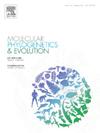Deciphering the patterns and timing of diversification of the genus Melanastera (Hemiptera: Psylloidea: Liviidae) in the Neotropics
IF 3.6
1区 生物学
Q2 BIOCHEMISTRY & MOLECULAR BIOLOGY
引用次数: 0
Abstract
Even after decades of research on diversification in the Neotropics, our understanding of the evolutionary processes that shaped Neotropical clades is still incomplete. In the present study, we used different divergence times and likelihood-based methods to investigate the influence of biogeography and host plant associations on the diversification of the most species-rich psyllid genus Melanastera (Liviidae) from the Neotropics as a model group of herbivorous insects. We used molecular phylogenetic data from seven gene fragments (four mitochondrial and three nuclear). The putatively monophyletic group of Neotropical Melanastera species has an estimated crown node age of 20.2 Ma (ML, CI 20.2–30.6) or 23.2 Ma (BI, 95 % HPD 16.6–32.6), with diversification occurring mainly in the Upper Miocene, although some species groups diversified in the Pliocene or Pleistocene. Biogeographic analysis suggests that the Neotropical Melanastera originated from the Pacific region of South and Central America. We detected a shift in diversification rates that likely occurred either at the time of origin of Melanastera or during the main colonisation of the Atlantic and Amazon Forests, followed by a subsequent slowdown in speciation rates. State-dependent speciation and extinction models revealed a significant relationship between this diversification shift and the shift of Melanastera to the plant families Melastomataceae and Annonaceae, reflecting the impact of host switching on speciation rates in this group. This period also coincides with several independent dispersal events from the Atlantic and Amazon Forests to other parts of the Neotropics. Taken together, the results of the current study suggest that diversification of Melanastera was facilitated by shifts to new host families, which may have promoted the dispersal of Melanastera into new adaptive zones with subsequent processes of local speciation.

新热带地区黑桫椤属(半翅目:木虱总科:桫椤科)多样化的模式和时间。
即使经过几十年对新热带地区多样性的研究,我们对形成新热带分支的进化过程的理解仍然不完整。在本研究中,我们利用7个基因片段(4个线粒体和3个核)的分子系统发育数据,采用不同的分化时间和基于似然的方法,研究了生物地理和寄主植物关联对物种最丰富的新热带木虱属Melanastera (Liviidae)多样化的影响,该属被用作食草昆虫的模型群。新热带Melanastera种的推定单系群的冠结年龄估计为20.2 Ma (ML, CI 20.2-30.6)或23.2 Ma (BI, 95% % HPD 16.6-32.6),多样化主要发生在中新世上部,尽管一些物种群在上新世和更新世发生多样化。生物地理学分析表明,新热带美拉斯特拉属起源于南美洲和中美洲的太平洋地区。我们发现了一种多样化速率的变化,这种变化可能发生在美拉娜斯特拉的起源时期,也可能发生在大西洋和亚马逊森林的主要殖民化时期,随后物种形成速率放缓。状态依赖的物种形成和灭绝模型揭示了这种多样化转变与Melanastera向Melastomataceae和Annonaceae植物科的转变之间的显著关系,反映了寄主转换对该类群物种形成率的影响。这一时期也发生了几次从大西洋和亚马逊森林到新热带其他地区的独立扩散事件。综上所述,目前的研究结果表明,向新的寄主家庭的转变促进了美拉斯特拉的多样化,这可能促进了美拉斯特拉在随后的当地物种形成过程中向新的适应区扩散。
本文章由计算机程序翻译,如有差异,请以英文原文为准。
求助全文
约1分钟内获得全文
求助全文
来源期刊
CiteScore
7.50
自引率
7.30%
发文量
249
审稿时长
7.5 months
期刊介绍:
Molecular Phylogenetics and Evolution is dedicated to bringing Darwin''s dream within grasp - to "have fairly true genealogical trees of each great kingdom of Nature." The journal provides a forum for molecular studies that advance our understanding of phylogeny and evolution, further the development of phylogenetically more accurate taxonomic classifications, and ultimately bring a unified classification for all the ramifying lines of life. Phylogeographic studies will be considered for publication if they offer EXCEPTIONAL theoretical or empirical advances.

 求助内容:
求助内容: 应助结果提醒方式:
应助结果提醒方式:


